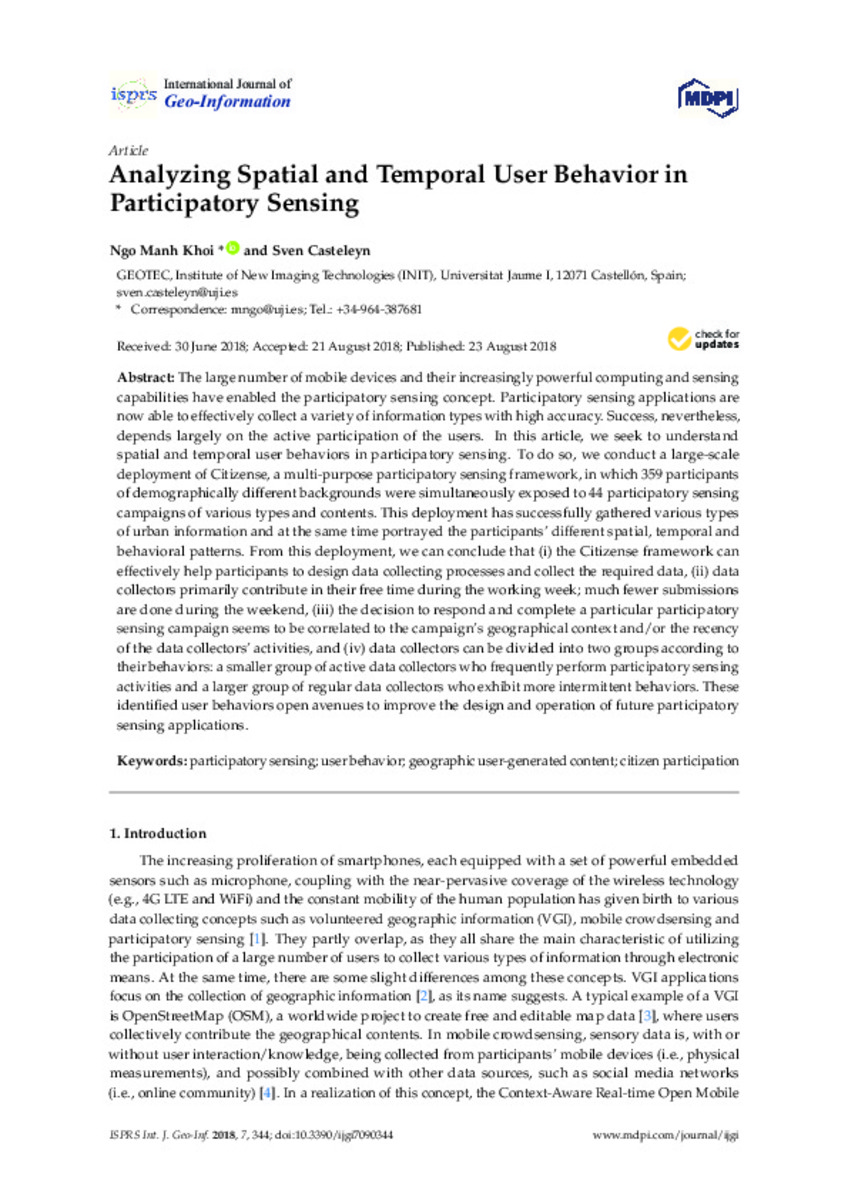Mostrar el registro sencillo del ítem
Analyzing Spatial and Temporal User Behavior in Participatory Sensing
| dc.contributor.author | Ngo, Manh Khoi | |
| dc.contributor.author | Casteleyn, Sven | |
| dc.date.accessioned | 2018-11-05T08:36:25Z | |
| dc.date.available | 2018-11-05T08:36:25Z | |
| dc.date.issued | 2018-08 | |
| dc.identifier.citation | Khoi, N.M.; Casteleyn, S. Analyzing Spatial and Temporal User Behavior in Participatory Sensing. ISPRS Int. J. Geo-Inf. 2018, 7, 344. | ca_CA |
| dc.identifier.uri | http://hdl.handle.net/10234/177190 | |
| dc.description.abstract | The large number of mobile devices and their increasingly powerful computing and sensing capabilities have enabled the participatory sensing concept. Participatory sensing applications are now able to effectively collect a variety of information types with high accuracy. Success, nevertheless, depends largely on the active participation of the users. In this article, we seek to understand spatial and temporal user behaviors in participatory sensing. To do so, we conduct a large-scale deployment of Citizense, a multi-purpose participatory sensing framework, in which 359 participants of demographically different backgrounds were simultaneously exposed to 44 participatory sensing campaigns of various types and contents. This deployment has successfully gathered various types of urban information and at the same time portrayed the participants’ different spatial, temporal and behavioral patterns. From this deployment, we can conclude that (i) the Citizense framework can effectively help participants to design data collecting processes and collect the required data, (ii) data collectors primarily contribute in their free time during the working week; much fewer submissions are done during the weekend, (iii) the decision to respond and complete a particular participatory sensing campaign seems to be correlated to the campaign’s geographical context and/or the recency of the data collectors’ activities, and (iv) data collectors can be divided into two groups according to their behaviors: a smaller group of active data collectors who frequently perform participatory sensing activities and a larger group of regular data collectors who exhibit more intermittent behaviors. These identified user behaviors open avenues to improve the design and operation of future participatory sensing applications | ca_CA |
| dc.format.extent | 30 p. | ca_CA |
| dc.format.mimetype | application/pdf | ca_CA |
| dc.language.iso | eng | ca_CA |
| dc.publisher | MDPI | ca_CA |
| dc.rights | © 2018 MDPI | ca_CA |
| dc.rights | Atribución 4.0 Internacional | * |
| dc.rights.uri | http://creativecommons.org/licenses/by-sa/4.0/ | * |
| dc.subject | participatory sensing | ca_CA |
| dc.subject | user behavior | ca_CA |
| dc.subject | geographic user-generated content | ca_CA |
| dc.subject | citizen participation | ca_CA |
| dc.title | Analyzing Spatial and Temporal User Behavior in Participatory Sensing | ca_CA |
| dc.type | info:eu-repo/semantics/article | ca_CA |
| dc.identifier.doi | https://doi.org/10.3390/ijgi7090344 | |
| dc.relation.projectID | European Commission GEO-C project (H2020-MSCA-ITN-2014, Grant Agreement No. 642332, http://www.geo-c.eu/) ; Spanish government. Ramón y Cajal Programme (Grant No. RYC-2014-16606) | ca_CA |
| dc.rights.accessRights | info:eu-repo/semantics/openAccess | ca_CA |
| dc.relation.publisherVersion | https://www.mdpi.com/2220-9964/7/9/344 | ca_CA |
| dc.contributor.funder | Association of Geographic Information Laboratories in Europe (AGILE) ; GEO-C | ca_CA |
| dc.type.version | info:eu-repo/semantics/publishedVersion | ca_CA |
Ficheros en el ítem
Este ítem aparece en la(s) siguiente(s) colección(ones)
-
INIT_Articles [743]








